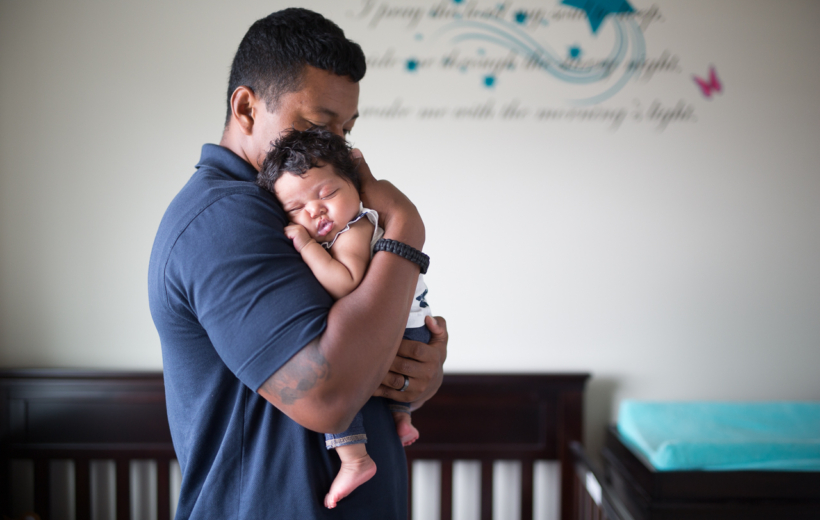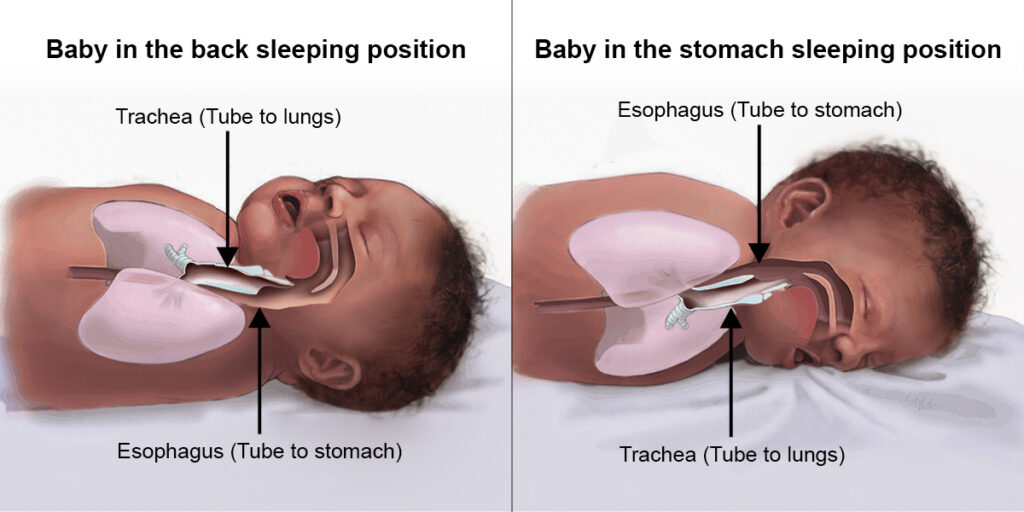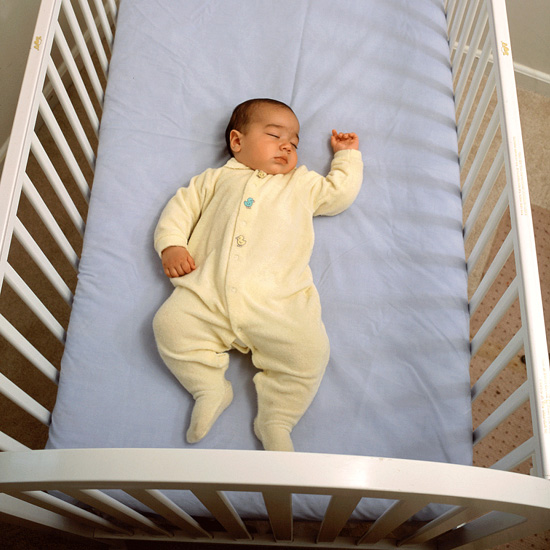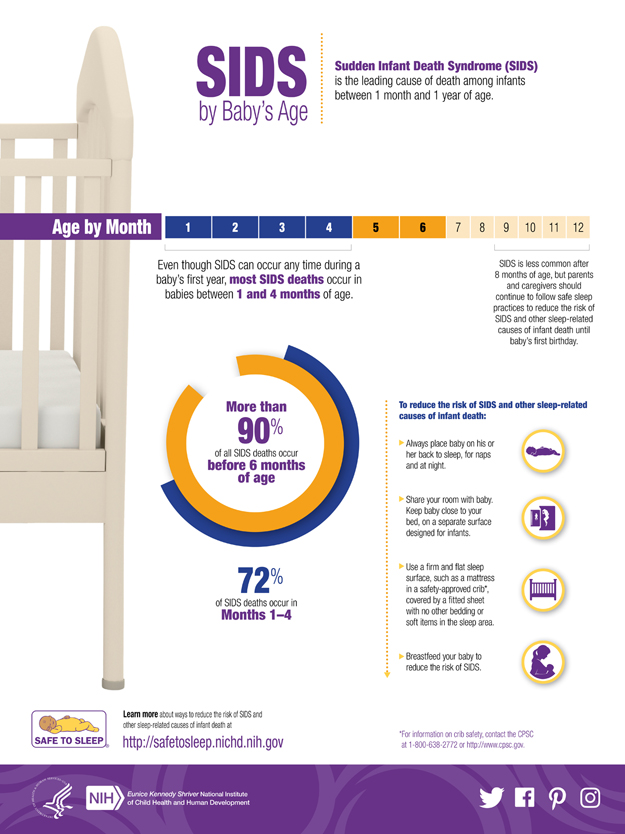
Right after a baby is born, parents hear from the nurse, “place your baby on her or his back to prevent SIDS”.
What is SIDS?
Sudden Infant Death Syndrome (SIDS) is the sudden and unexplained death of a child younger than 1 year old. Most cases occur when the infant is supposed to be sleeping, which is why the phrase “crib death” is also used.
SIDS is the leading cause of death among infants 1 month to 1 year of age. Most SIDS deaths occur between 1 and 4 months of age. There are about 3,400 cases of SIDS and sleep-related suffocation events per year in the United States. SIDS is diagnosed after all other possible causes are ruled out.
Decreasing the risk of SIDS
SIDS occurs more often in infants placed on their stomachs to sleep than in those placed on their backs. Infants should not be placed on their side to sleep because they can easily roll onto their stomach.
Some researchers believe that stomach sleeping may increase “rebreathing” – as babies rebreathe exhaled air, the oxygen level in their body drops as the level of carbon dioxide increases. This can also occur when babies are sleeping on soft surfaces or with pillows, bedding, or toys near their face. If a baby is not getting enough oxygen, the brain usually triggers them to wake up to get more oxygen. Babies who die from SIDS may have a problem with the part of the brain that helps control breathing and waking during sleep.
Placing an infant to sleep on their back allows exhaled air to leave the area around the face so that fresh oxygen is available. As a result, the Safe to Sleep campaign was launched in 1994 with the recommendation that babies be placed on their backs to sleep. Since the start of this campaign, the incidence of SIDS has declined by over half.

Image courtesy of the Safe to Sleep® campaign, for educational purposes only; Eunice Kennedy Shriver National Institute of Child Health and Human Development, http://www.nichd.nih.gov/sids; Safe to Sleep® is a registered trademark of the U.S. Department of Health and Human Services.
All healthy infants younger than 1 year old should be placed on their backs to sleep.
Also, be sure they are on a firm, flat crib mattress and do not sleep with soft objects, loose blankets, or pillows.
Safe sleep guidelines
Even though medical professionals don’t know the exact cause of SIDS, research shows there are effective ways you can reduce the risk, such as selecting a safe crib and creating a safe sleeping environment for your baby.
What to look for in a safe crib
- Safe slat distance: Slats should be spaced no more than 2-3/8 inches apart to protect babies from falling out or getting trapped.
- Solid headboards and footboards: Boards with decorative cutouts can cause injuries or snag clothing.
- A crib with no drop-side rail: Cribs with movable side rails are unsafe and have been banned by the Consumer Product Safety Commission.
- Raised crib sides: The top of the crib rail should be at least 26 inches from the top of the mattress. Lower the mattress as your child gets taller. Once children are about 3 feet tall, it is time to transition to a bed or mattress on the floor.
- A firm mattress: Make sure the mattress is very firm, flat, and fits snugly with no space between it and the walls of the crib.
Remember to place the crib away from windows, radiator/heating elements, and strings from blinds or curtains that may pose a strangulation risk.
The ABCs of safe sleep

Image courtesy of the Safe to Sleep® campaign, for educational purposes only; Eunice Kennedy Shriver National Institute of Child Health and Human Development, http://www.nichd.nih.gov/sids; Safe to Sleep® is a registered trademark of the U.S. Department of Health and Human Services.
A – Alone
Babies should sleep alone in their own sleep space. Bedsharing is not recommended, but room-sharing is until your baby is at least 6 months old, but ideally until they are 1 year old. Keep pillows, blankets, toys, and other soft items out of their sleeping space. Babies can use a pacifier in the crib as long it is not attached to the baby or crib.
B – Back
Always place babies on their backs for sleep for naps and at night. Once they can consistently roll both ways, it’s fine to let them sleep in any position they choose but continue placing them on their backs initially.
C – Crib
Use a safety-approved crib, bassinet, or portable play yard with a firm, flat mattress and fitted sheet. Avoid bumpers and anything attached to a crib, such as a monitor or mobile.
Further recommendations to reduce the risk of SIDS
- Do not leave a baby unsupervised in products that aren’t designed for safe sleep such as an inclined product.
- Regularly check websites like CPSC.gov or SaferProducts.gov for recalls.
- Move your baby to their crib, bassinet, or play yard if they fall asleep elsewhere.
- Breastmilk and pacifier use are recommended because they have been associated with a reduced risk of SIDS.
- Avoid overheating and head covering in babies.
- Start supervised tummy time soon after birth, increasing to 30 minutes total daily by 7 weeks old. This helps facilitate development and minimizes positional plagiocephaly.
- Do not smoke or let anyone else smoke around your baby.
- Stay up to date on immunizations due for your baby.
- Stop swaddling when your baby shows signs of trying to roll over. Some babies start as early as 2 months of age.
- Avoid the use of commercial devices marketed to reduce the risk of SIDS.
Learn more
- Interactive layout of a safe sleep environment
- Ways to Reduce Baby’s Risk from Safe to Sleep®
- How to Keep Your Sleeping Baby Safe: AAP Policy Explained from AAP’s Healthy Children website.
The original version of this article was written by Tracy Lin, ARNP. It has been revised and updated by Wendy Jin, MD, MPH.
Related Stories




